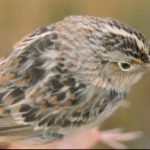Article By Master Gardener and Master Naturalist Don Philpott (dp@mediawiseus.com). Read Don’s other articles [here].
March 20 is World Sparrow Day but for one sparrow it may be too late.
For most of us the pleasure of gardening is not just in growing things, it is being able to provide habitats for birds, bees, butterflies and other creatures.
As the human population throughout Central Florida continues to grow, more and more natural habitats are being lost. As gardeners we can plant flowers and shrubs that attract many species and a well-planned garden can be abuzz with birds, bees and butterflies for much of the year.
For some creatures, however, time is running out. March 20 is World Sparrow Day and central Florida is the home of the Florida grasshopper sparrow (Ammodramus savannarum floridanus). By the time we celebrate World Sparrow Day in 2019, this species might be almost extinct.
There are about 35 species of sparrows in North America and four species of grasshopper sparrow. The Florida grasshopper sparrow is the rarest, although all the grasshopper sparrows are threatened. At the last count in 2017, it was estimated that there were only between 50 and 60 sparrows in the wild in central and southern Florida – down from around 1,000 in 2004. The species was listed as endangered by the state of Florida in 1977 mostly because of habitat loss.

Specialized habitat needs
The Florida grasshopper sparrow likes large areas (over 120 acres) of dry, flat, poorly drained and almost treeless prairies that are subject to fire, either natural or prescribed, every two or three years. The vegetation is mostly saw palmetto, dwarf oaks, bluestem grass, St. John’s Wort and wiregrass. Incredibly, they cannot exist in areas where there is a tree density of more than one tree an acre.
The Florida grasshopper sparrow is about five inches long with a short tail and rounded head. Its call is like a grasshopper which is where it gets its name. Its diet consists largely of grasshoppers, crickets, beetles and other insects.
Apart from habitat loss, there are two other reasons why the population has declined dramatically. They are the only grasshopper sparrow to breed in Florida. It nests in shallow sandy depressions on the ground so predation of eggs and nestlings is high, especially by fire ants. It is also non-migratory so isolated populations aren’t able to find breeding partners in other colonies.
So on March 20 as we celebrate all those “little brown birds” let’s give a thought for the Florida grasshopper sparrow. Then, look at your own garden and see what you do to make it more wildlife friendly so we provide habitats for more critters.
 0
0

Comments are closed.